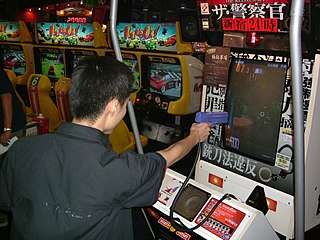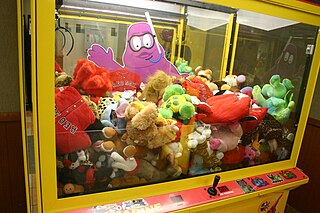
An arcade video game takes player input from its controls, processes it through electrical or computerized components, and displays output to an electronic monitor or similar display. All arcade video games are coin-operated or accept other means of payment, housed in an arcade cabinet, and located in amusement arcades alongside other kinds of arcade games. Until the early 2000s, arcade video games were the largest and most technologically advanced segment of the video game industry.

Pachinko (パチンコ) is a mechanical game originating in Japan that is used as an arcade game, and much more frequently for gambling. Pachinko fills a niche in Japanese gambling comparable to that of the slot machine in the West as a form of low-stakes, low-strategy gambling.

An amusement arcade, also known as a video arcade, amusements, arcade, or penny arcade, is a venue where people play arcade games, including arcade video games, pinball machines, electro-mechanical games, redemption games, merchandisers, or coin-operated billiards or air hockey tables. In some countries, some types of arcades are also legally permitted to provide gambling machines such as slot machines or pachinko machines. Games are usually housed in cabinets.

Sega Sammy Holdings Inc. is a Japanese global holding company formed from the merger of Sega and Sammy Corporation in 2004. Both companies are involved in the amusement industry.
Redemption games are typically arcade games of skill that reward the player proportionally to their score in the game. The reward most often comes in the form of tickets, with more tickets being awarded for higher scores. These tickets can then be redeemed at a central location for prizes. The most inexpensive prizes may require only a small number of tickets to acquire, while the most expensive ones may require several thousand. In general, the amount of money spent to win enough tickets for a given prize will exceed the value of the prize itself. Some redemption games, such as Flamin' Finger, involve elements of chance, which can be set by the operator.

Banpresto Co., Ltd. was a Japanese video game developer and publisher headquartered in Shinagawa, Tokyo. It had a branch in Hong Kong named Banpresto H.K., which was headquartered in the New Territories. Banpresto was a partly-owned subsidiary of toymaker Bandai from 1989 to 2006, and a wholly-owned subsidiary of Bandai Namco Holdings from 2006 to 2008. In addition to video games, Banpresto produced toys, keyrings, apparel, and plastic models.

An electronic game is a game that uses electronics to create an interactive system with which a player can play. Video games are the most common form today, and for this reason the two terms are often used interchangeably. There are other common forms of electronic game including handheld electronic games, standalone systems, and exclusively non-visual products.
Virtua Fighter is a series of fighting games created by Sega-AM2 and designer Yu Suzuki. The original Virtua Fighter was released in October 1993 and has received four main sequels and several spin-offs. The highly influential first Virtua Fighter game is widely recognized as the first 3D fighting game released.

Joypolis is a chain of indoor amusement parks created by Sega and run by CA Sega Joypolis. Beginning on July 20, 1994 with the original location sited in Yokohama, Japan, Joypolis centers have since opened in several cities in Japan and later China. The parks feature arcade games and amusement rides based on Sega's intellectual properties, original themes, and licensed franchises. Alongside the predecessor Galbo venues and the overseas spin-offs SegaWorld London and Sega World Sydney, they were officially referred to under the "Amusement Theme Park" or "ATP" concept by Sega in the 1990s.
Sega World, sometimes stylized as SegaWorld, is a formerly international chain of amusement arcades and entertainment centres created by Sega. Though not the first venues to be developed by the company, with operations dating back to the late 1960s in Japan, it would come to involve some of their most prolific and successful examples in the 1990s and 2000s. During their peak period in the 1990s, there were likely at least several hundred Sega World locations across the world.

A traveling carnival, usually simply called a carnival, or travelling funfair, is an amusement show that may be made up of amusement rides, food vendors, merchandise vendors, games of chance and skill, thrill acts, and animal acts. A traveling carnival is not set up at a permanent location, like an amusement park or funfair, but is moved from place to place. Its roots are similar to the 19th century circus with both being fitted-up in open fields near or in town and moving to a new location after a period of time. In fact, many carnivals have circuses while others have a clown aesthetic in their decor. Unlike traditional carnival celebrations, the North American traveling carnival is not tied to a religious observance.

A carnival game is a game of chance or skill that can be seen at a traveling carnival, charity fund raiser, amusement arcade and amusement park, or on a state and county fair midway. They are also commonly played on holidays such as Mardi Gras, Saint Patrick's Day, and Oktoberfest.

Sega Toys Co., Ltd. is a Japanese toy company and animation studio, which is a wholly owned subsidiary of Sega Sammy Holdings. The company was founded when Yonezawa Toys, Japan's largest post-war toy manufacturer, was absorbed into Sega in 1991 as Sega-Yonezawa.

Thunder Blade is a third-person shoot 'em up video game released by Sega for arcades in 1987. Players control a helicopter to destroy enemy vehicles. The game was released as a standard stand-up arcade cabinet with force feedback, as the joystick vibrates. A helicopter shaped sit-down model was released, replacing the force feedback with a cockpit seat that moves in tandem with the joystick. It is a motion simulator cabinet, like the previous Sega Super Scaler games Space Harrier (1985) and After Burner (1987). The game's plot and setting was inspired by the film Blue Thunder (1983).

A merchandiser is an arcade gaming device, which features a machine that contains a display of merchandise, which can be won by playing the game. In the trade, such games are described as "skill with prize" (SWP) games, and are a hybrid of games of skill and games of chance, with the preponderance of skill or chance differing between devices and often able to be set by the operator.
A skill with prize or skill with prizes (SWP) machine is a gaming machine which provides a payout and whose outcome depends in part on the player's skill. They are contrasted with amusement with prize machines which, while interactive, do not depend on the player's skill in determining outcome.

Sega Corporation is a Japanese multinational video game and entertainment company headquartered in Shinagawa, Tokyo. Its international branches, Sega of America and Sega Europe, are headquartered in Irvine, California and London, respectively. Its division for the development of both arcade games and home video games, Sega Games, has existed in its current state since 2020; from 2015 to that point, the two had made up separate entities known as Sega Games and Sega Interactive Co., Ltd. Sega is a subsidiary of Sega Sammy Holdings. From 1983 until 2001, Sega also developed video game consoles.
ALL.Net is an arcade video game network communication system and digital distribution system made by Sega Corporation. It is similar to the Taito NESiCAxLive game distribution systems and NESYS arcade network; the player smart card system is similar to the Konami e-AMUSEMENT system. It enables arcade games to be connected via the Internet, enabling communication battles, national rankings, and storage of play data,

An arcade game or coin-op game is a coin-operated entertainment machine typically installed in public businesses such as restaurants, bars and amusement arcades. Most arcade games are presented as primarily games of skill and include arcade video games, pinball machines, electro-mechanical games, redemption games or merchandisers.


















